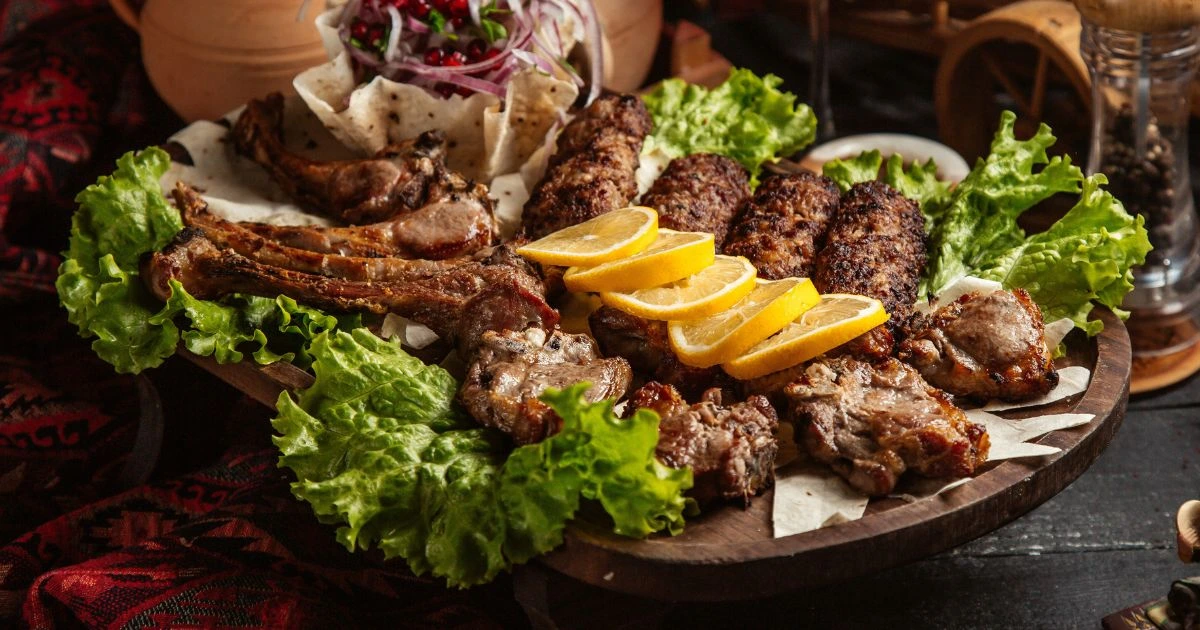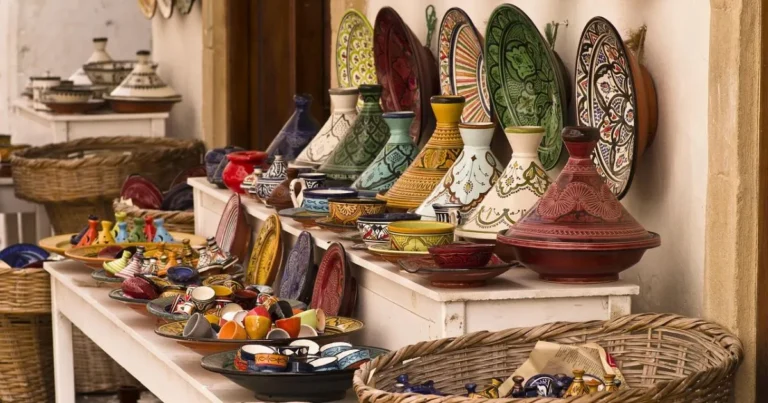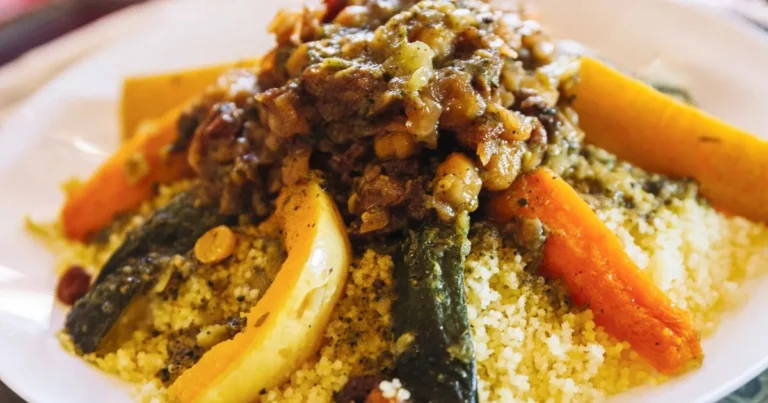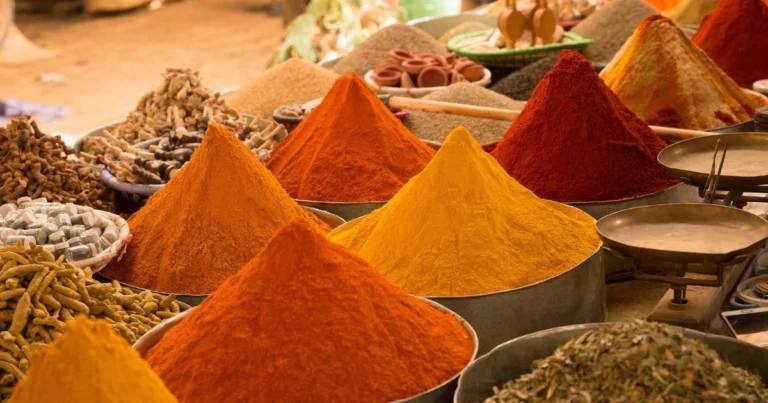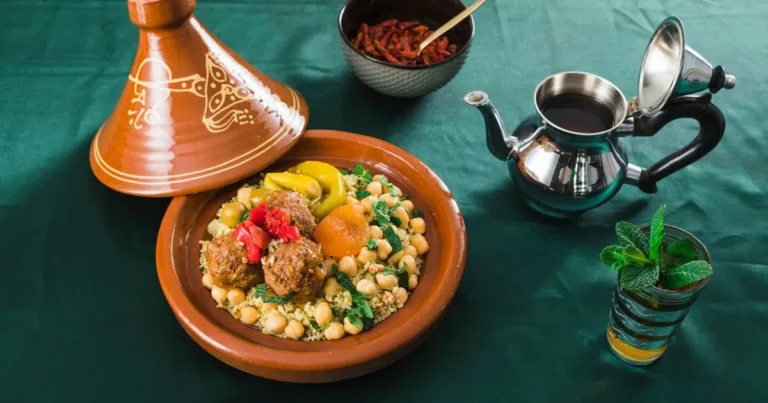The Ultimate Guide to Mechoui for 2025 : Traditional North African Slow-Roasted Lamb
Table of Contents
When it comes to authentic North African cuisine, few dishes command as much respect and admiration as mechoui. This ancient culinary tradition transforms humble lamb into a feast fit for kings, using time-honored techniques that have been passed down through generations. Whether you’re searching for the best mechoui near me or planning to master this incredible lamb mechoui at home, this comprehensive guide will take you on a flavorful journey through everything you need to know about this spectacular dish.
What is Mechoui? A Comprehensive Definition
Mechoui (pronounced “meh-SHWAY”) is far more than just roasted lamb—it’s a celebration of community, tradition, and culinary artistry. At its core, mechoui refers to a whole lamb (or large portions of lamb) that is slow-roasted over an open fire or in a traditional pit oven, seasoned with aromatic spices and herbs that create an unforgettable flavor profile.
The term itself derives from the Arabic word “shawa,” meaning “to roast,” which reflects the cooking method’s fundamental importance to the dish’s identity. You might encounter various spellings including “meshwi,” “mashawi,” or “mechoui,” depending on the regional dialect and transliteration preferences.
Key Characteristics of Authentic Mechoui:
- Slow-cooking method: Traditionally cooked for 6-12 hours
- Whole animal preparation: Often uses an entire lamb or large sections
- Community event: Typically prepared for large gatherings and celebrations
- Aromatic spice blend: Features cumin, coriander, garlic, and regional herbs
- Crispy exterior, tender interior: Perfect balance of textures
The Rich Historical Background Of Mechoui
The origins of mechoui stretch back centuries into the heart of North African Berber culture. This cooking method emerged from the practical needs of nomadic tribes who required efficient ways to prepare large quantities of meat for extended families and communities.
Ancient Roots and Cultural Significance
Archaeological evidence suggests that slow-roasting techniques similar to modern mechoui were practiced by Berber tribes as early as the 8th century. The method served multiple purposes:
- Preservation: Slow cooking helped preserve meat in hot climates
- Celebration: Large roasted animals marked important occasions
- Community bonding: The lengthy cooking process brought people together
- Resource optimization: Every part of the animal was utilized
“Mechoui is not just food—it’s a bridge between generations, connecting us to our ancestors through the ancient art of fire and patience.” – Chef Aicha Benali, Marrakech
Evolution Through the Centuries
Trade route expansion throughout North Africa facilitated the dissemination and development of mechoui cooking methods. The dish absorbed influences from:
- Arab spice traders: Introduction of exotic spices and seasoning techniques
- Ottoman cuisine: Refined cooking methods and presentation styles
- French colonial period: Integration with European cooking principles
- Modern adaptations: Contemporary equipment and urban cooking solutions
Regional Variations: A Tapestry of Flavors
The beauty of mechoui lies in its regional diversity. Each area of North Africa has developed its own distinctive approach to this beloved dish.
Moroccan Mechoui
Characteristics:
- Heavy use of preserved lemons and olives
- Ras el hanout spice blend
- Traditional tagine-style preparation options
- Accompaniment with mint tea
Flavor Profile: Complex, aromatic, with citrusy notes and warm spices
Algerian Mechoui
Characteristics:
- Emphasis on harissa and hot peppers
- Couscous as the traditional side dish
- Underground pit cooking methods
- Stronger emphasis on garlic and herbs
Flavor Profile: Spicier, more robust, with earthy undertones
Tunisian Mechoui
Characteristics:
- Integration of Mediterranean influences
- Use of local olive oils and herbs
- Smaller portion sizes for family meals
- Creative urban adaptations
Flavor Profile: Lighter, more herb-forward, with olive oil richness
Libyan Mechoui
Characteristics:
- Traditional Bedouin preparation methods
- Desert herbs and minimal water usage
- Focus on natural lamb flavors
- Ancient pit cooking techniques
Flavor Profile: Pure, intense lamb taste with subtle herb notes
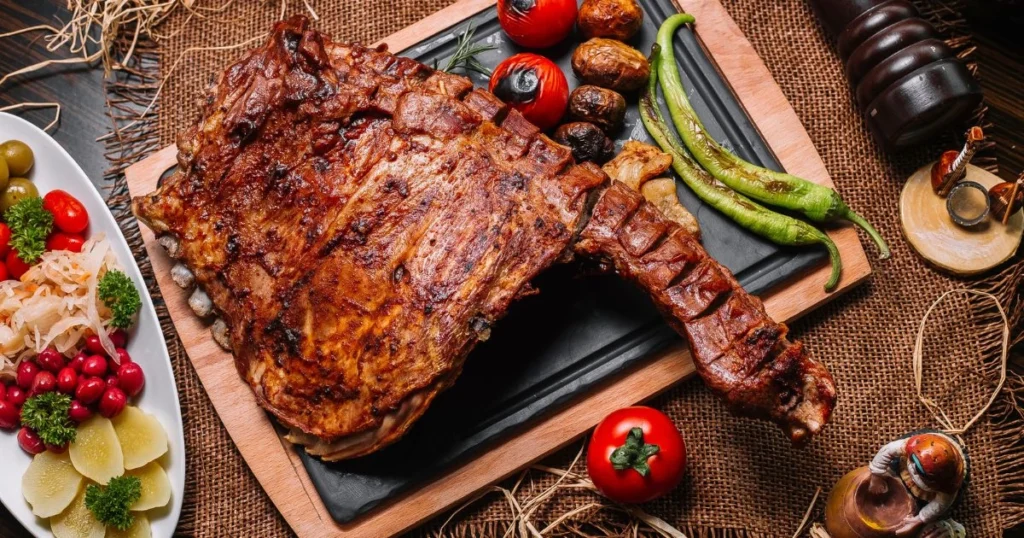
Traditional Mechoui Recipe: Step-by-Step Guide
Ready to create your own authentic lamb mechoui? This traditional recipe serves 15-20 people and requires advance planning, but the results are absolutely worth the effort.
Ingredients
| Main Ingredients | Quantity |
|---|---|
| Whole leg of lamb (bone-in) | 6-8 lbs |
| Coarse sea salt | 3 tablespoons |
| Ground cumin | 2 tablespoons |
| Ground coriander | 2 tablespoons |
| Paprika | 1 tablespoon |
| Ground ginger | 1 teaspoon |
| Turmeric | 1 teaspoon |
| Black pepper | 1 teaspoon |
| Aromatics | Quantity |
|---|---|
| Fresh garlic cloves | 8-10 cloves |
| Fresh ginger root | 2-inch piece |
| Fresh cilantro | 1 large bunch |
| Fresh parsley | 1 large bunch |
| Preserved lemons | 4-5 lemons |
| Olive oil | 1/4 cup |
Preparation Instructions
Phase 1: Marination (24-48 hours before cooking)
- Prepare the spice mixture: Mix all dry seasonings together in a large bowl until evenly blended.
- Prepare the aromatics:
- Mince garlic and fresh ginger into a paste
- Finely chop cilantro and parsley
- Dice preserved lemons, removing excess salt
- Score the lamb: Make deep cuts (about 1 inch deep) across the surface of the lamb, spacing them 2 inches apart. This allows the marinade to penetrate deeply.
- Apply the marinade:
- Rub the spice mixture all over the lamb, working it into the cuts
- Stuff the aromatic paste into the cuts and cavity
- Massage olive oil over the entire surface
- Wrap tightly in plastic wrap and refrigerate
Phase 2: Cooking Preparation
- Equipment setup:
- Prepare your cooking fire or oven
- Set up a drip pan to catch juices
- Have a meat thermometer ready
- Prepare basting brush and extra olive oil
Phase 3: Slow Roasting (6-8 hours)
- Initial searing (30 minutes):
- Heat your cooking surface to high heat
- Brown the lamb thoroughly on every surface until it develops a golden color
- This seals in the natural juices and develops the coveted exterior crust
- Slow cooking phase:
- Reduce heat to low (225-250°F for oven cooking)
- Position lamb on a rack over drip pan
- Cook for 6-8 hours, moistening hourly with the collected cooking juices
- Internal temperature should reach 135°F for medium-rare
- Final crisping (15-20 minutes):
- Increase heat for final browning
- Watch carefully to prevent burning
- Rest the meat for 20-30 minutes before carving
Pro Tips for Perfect Mechoui
- Temperature consistency: Maintain steady, low heat throughout cooking
- Moisture management: Keep a water pan in the cooking area to prevent drying
- Basting technique: Use accumulated drippings mixed with fresh olive oil
- Doneness testing: Use a meat thermometer in the thickest part of the leg
- Resting importance: Allow proper resting time for juice redistribution
Essential Equipment Guide for Mechoui
Creating authentic mechoui requires the right tools. Here’s your comprehensive equipment guide:
Traditional Methods
Spit Roasting Setup
- Mechanical spit: Heavy-duty rotating spit system
- Fire management: Hardwood charcoal or oak logs
- Drip management: Large collection pan and basting tools
Pit Cooking Equipment
- Digging equipment: Shovels and measuring instruments for pit construction
- Heat retention: Fire bricks or stones for even heat distribution
- Covering materials: Heavy canvas or specialized pit covers
Modern Adaptations
Large Capacity Ovens
- Size requirements: Minimum 30-inch capacity for whole leg
- Temperature control: Precise low-temperature capabilities
- Ventilation: Proper exhaust for smoke management
Outdoor Grill Modifications
- Indirect heat setup: Two-zone cooking configuration
- Rotisserie attachments: Heavy-duty motor systems
- Temperature monitoring: Digital probe thermometers
Essential Tools Checklist
- [ ] Heavy-duty carving knife
- [ ] Meat thermometer (instant-read and probe types)
- [ ] Basting brush and mop
- [ ] Heat-resistant gloves
- [ ] Large cutting board
- [ ] Sharp boning knife for preparation
- [ ] Aluminum foil for resting
- [ ] Clean towels for handling
Perfect Serving Suggestions
The presentation and accompaniments for mechoui are just as important as the cooking process itself. Here are traditional and modern serving ideas:
Traditional Accompaniments
Bread and Grains
- Khubz (flatbread): Warm, pillowy bread for wrapping meat
- Couscous: Light, fluffy grains that absorb the lamb juices
- Aromatic rice dish: Spiced rice combined with almonds and dried fruits
Vegetable Sides
- Grilled vegetables: Eggplant, zucchini, and bell peppers
- Moroccan salads: Tomato and cucumber with fresh herbs
- Preserved vegetables: Pickled turnips and carrots
Sauce Pairings
| Sauce Type | Ingredients | Flavor Profile |
|---|---|---|
| Harissa | Hot peppers, garlic, spices | Spicy, aromatic |
| Chermoula | Herbs, garlic, lemon, oil | Fresh, tangy |
| Tahini | Sesame paste, lemon, garlic | Creamy, nutty |
| Yogurt mint | Greek yogurt, mint, cucumber | Cool, refreshing |
Beverage Recommendations
Traditional Options
- Mint tea: Sweet, refreshing complement to rich lamb
- Buttermilk: Cooling dairy beverage
- Rose water drinks: Floral, festive options
Modern Pairings
- Red wine: Full-bodied Cabernet Sauvignon or Malbec
- Craft beer: Malty brown ales or wheat beers
- Cocktails: Pomegranate-based drinks with Middle Eastern spices
Nutritional Information and Health Benefits
Understanding the nutritional profile of lamb mechoui helps you make informed dietary choices while enjoying this traditional dish.
Nutritional Breakdown (per 4 oz serving)
| Nutrient | Amount | % Daily Value |
|---|---|---|
| Calories | 280-320 | 14-16% |
| Protein | 26-30g | 52-60% |
| Fat | 18-22g | 28-34% |
| Saturated Fat | 8-10g | 40-50% |
| Cholesterol | 85-95mg | 28-32% |
| Iron | 2.5-3mg | 14-17% |
| Zinc | 4-5mg | 36-45% |
| Vitamin B12 | 2.5-3mcg | 104-125% |
Health Benefits
High-Quality Protein
- Complete amino acid profile: Contains all essential amino acids
- Muscle maintenance: Supports lean muscle mass
- Satiety: Helps maintain feeling of fullness
Essential Minerals
- Iron absorption: Heme iron for better absorption
- Zinc content: Supports immune system function
- B-vitamin complex: Energy metabolism support
Considerations for Healthy Consumption
- Portion control: Stick to 4-6 oz servings
- Balance with vegetables: Include plenty of fresh vegetables
- Cooking method: Traditional slow-roasting preserves nutrients
- Quality sourcing: Choose grass-fed lamb when possible
Ethical Sourcing and Sustainability
As conscientious consumers, it’s important to consider the environmental and ethical implications of our food choices, including mechoui preparation.
Sustainable Lamb Sourcing
What to Look For:
- Grass-fed certification: Animals raised on natural pastures
- Local producers: Reduced transportation environmental impact
- Humane treatment: Third-party welfare certifications
- Organic practices: No synthetic hormones or antibiotics
Questions to Ask Your Butcher:
- Where was this lamb raised?
- What did the animals eat?
- Are there any certifications for animal welfare?
- When was the animal processed?
- Do you work directly with local farms?
Environmental Considerations
Carbon Footprint Reduction:
- Local sourcing: Choose regional suppliers when possible
- Seasonal cooking: Align preparation with natural lamb seasons
- Waste reduction: Use all parts of the animal
- Energy efficiency: Optimize cooking methods for fuel conservation
Supporting Local Communities
Purchasing lamb from local farmers and preparing mechoui for community gatherings supports:
- Local economy: Direct support for regional agriculture
- Cultural preservation: Maintaining traditional cooking methods
- Community building: Bringing people together through food
- Knowledge transfer: Teaching traditional techniques to younger generations
Frequently Asked Questions
Q: How long does it take to cook mechoui?
A: Traditional mechoui requires 6-8 hours of slow cooking, plus 24-48 hours for marination. Plan for a full day of preparation and cooking.
Q: Can I make mechoui in a regular home oven?
A: Yes! While traditional methods use open fire, you can successfully prepare lamb mechoui in a large home oven set to 225-250°F. Place in a roasting pan with rack and baste frequently.
Q: What’s the best cut of lamb for mechoui?
A: A whole leg of lamb (6-8 lbs) is ideal for traditional mechoui. For smaller gatherings, use a bone-in leg portion or shoulder roast.
Q: How do I know when the mechoui is done?
A: Insert a meat thermometer into the thickest portion of the meat. Target 135°F for medium-rare, 145°F for medium. The meat should yield easily to a fork and shred effortlessly.
Q: Can I prepare mechoui ahead of time?
A: The marination must be done 1-2 days ahead. Cooked mechoui can be partially prepared and finished on serving day, though fresh cooking yields the best results.
Q: What if I can’t find preserved lemons?
A: You can make quick preserved lemons by salting lemon wedges for 2-3 hours, or substitute with fresh lemon zest and a pinch of salt.
Q: Is mechoui spicy?
A: Traditional mechoui is aromatic rather than spicy-hot. The heat level depends on regional variations—Moroccan versions tend to be milder, while Algerian preparations can be spicier.
Q: How many people does one leg of lamb serve?
A: A 6-8 lb leg of lamb typically serves 15-20 people when accompanied by traditional sides and bread.
Finding the Best Mechoui Near You
If you’re not ready to tackle this ambitious cooking project at home, finding authentic mechoui at local restaurants can be an excellent way to experience this traditional dish.
What to Look For in Restaurants:
Authenticity Indicators:
- North African ownership: Restaurants run by Moroccan, Algerian, or Tunisian families
- Traditional preparation: Asks about cooking methods and timing
- Fresh preparation: Mechoui made to order rather than pre-cooked
- Community reputation: Popular with local North African communities
Questions to Ask:
- “How long do you cook your mechoui?”
- “Do you use traditional spice blends?”
- “Is the lamb sourced locally?”
- “Can you accommodate large group orders?”
Restaurant Research Tips:
- Check online reviews for mentions of authenticity
- Look for restaurants that offer catering services
- Ask about advance ordering for fresh preparation
- Inquire about traditional accompaniments and sides
Hosting a Mechoui Event
Transform your next gathering into an unforgettable cultural experience by centering it around authentic mechoui.
Event Planning Checklist
2-3 Weeks Before:
- [ ] Source quality lamb from local butcher or farm
- [ ] Send invitations with cultural context explanation
- [ ] Plan traditional decorations and music
- [ ] Arrange cooking equipment and fuel sources
1 Week Before:
- [ ] Confirm guest count and dietary restrictions
- [ ] Prepare spice blends and aromatics
- [ ] Set up cooking area and safety measures
- [ ] Plan side dishes and beverages
Day of Event:
- [ ] Begin cooking process early morning
- [ ] Set up communal dining area
- [ ] Prepare accompaniments and sides
- [ ] Create ambiance with traditional music and decor
Cultural Context and Education
Help your guests appreciate the cultural significance by:
- Sharing the history: Brief explanation of mechoui traditions
- Demonstrating techniques: Show traditional carving and serving methods
- Encouraging participation: Let guests help with final preparations
- Creating connection: Share stories about community and celebration
Conclusion: Embracing the Mechoui Tradition
Its represents more than just a cooking technique—it embodies the spirit of hospitality, community, and cultural preservation that defines North African cuisine. Whether you’re preparing your first lamb mechoui at home or seeking out the best mechoui near me at an authentic restaurant, you’re participating in a culinary tradition that has brought people together for centuries.
The slow, patient process of creating perfect mechoui mirrors the values of traditional culture: respect for quality ingredients, dedication to craft, and the understanding that the best meals are worth waiting for. In our fast-paced modern world, taking the time to prepare and share mechoui becomes an act of mindfulness and community building.
Your Mechoui Journey Starts Now
Ready to embark on your own mechoui adventure? Start by:
- Finding quality lamb: Connect with local farmers or specialty butchers
- Gathering your community: Plan a gathering that brings people together
- Preparing with patience: Allow time for proper marination and cooking
- Sharing the experience: Teach others about this beautiful tradition
The magic of mechoui lies not just in its incredible flavors, but in its power to create lasting memories and strengthen community bonds. Every time you prepare or share this dish, you’re keeping alive a tradition that has nourished both bodies and souls for generations.
Call to Action: Have you tried making mechoui at home, or do you have a favorite restaurant where you’ve experienced this incredible dish? Share your mechoui stories and photos in the comments below—let’s build a community of mechoui enthusiasts who appreciate this remarkable culinary tradition! Don’t forget to bookmark this guide for your next mechoui adventure and share it with friends who love exploring authentic world cuisines.

